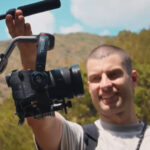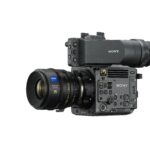Blackmagic Design today announced that the award winning short documentary “Soul of Storm,” directed and produced by Chinese student filmmaker and storm chaser Dike Su, was filmed using Blackmagic URSA Mini Pro 12K and Blackmagic Pocket Cinema Camera 4K digital film cameras. The post production process, including editing, color grading, and audio post production, was all completed with DaVinci Resolve Studio.
“Soul of Storm” is a short nature documentary that captures intense meteorological phenomena, including typhoons and severe convective weather such as thunderstorms, from the unique perspective of a storm chaser. The film has achieved notable recognition, clinching the Best Short Documentary award at the Roma Short Film Festival and earning selection in numerous other prestigious film festivals.
Su, currently a graduate student at Communication University of China, is also a prominent content creator on Bilibili, one of China’s most popular video sharing and streaming platforms. His Bilibili channel, “Fengyujiang-SDK,” is dedicated to demystifying weather knowledge and providing insights into storm chasing adventures and has garnered a substantial following of more than 300 thousand subscribers and 30 million views. Su has been captivated by severe convective weather phenomena since childhood, and his passion led him to explore the myths surrounding them. In 2019, upon entering Communication University of China, he embarked on a journey into photography and cinematography.
To unravel the intricacies of weather patterns and capture firsthand video footage and data, Su and his partners would set out to track down every time a typhoon lands on China, which would involve covering a vast distance and navigating through the eye of the storm multiple times. They do the filming and collect the data on the ground, potentially augmenting the information gathered by meteorological authorities. The data can serve as a valuable reference for subsequent scientific research and aid in the investigation of the typhoon’s causes. He aspired to produce a documentary film showcasing rarely seen storms and started preparations in 2018. “I chose the Pocket Cinema Camera 4K for this project for its compact, portable design and exceptional image quality. It was perfect for handheld shooting without requiring too many accessories,” he explained.
In 2022, Su added an URSA Mini Pro 12K to his toolkit. “Despite being a new camera, the familiar operating system shared with my Pocket Cinema Camera 4K allowed me to quickly adapt and maximize its capabilities,” he said. Speaking of using the URSA Mini Pro 12K for this project, he clarified that while he wasn’t obsessed with resolution, he aimed to capture rare weather phenomena at the highest possible quality, especially those that might not occur again in one’s lifetime. “For those unfamiliar with the URSA Mini Pro 12K, it might sound like a storage intensive monster. However, thanks to the efficient and visually lossless Blackmagic RAW codec, offering various options, the 12K footage’s size was even smaller than the 4K footage recorded with other codecs. This allowed me to shoot in 12K 8:1 without concerns,” Su shared. “For regular scenes, I would opt for 8K 8:1 or 12:1.”
“I’m happy the most amazing shots were captured in 12K. Although the resolution of my display is just 4K, who knows what larger resolution TVs or monitors will be available to viewers and content creators in the future? 12K is not only for display but also provides meteorological scientists with more valuable information.” Looking back on the shoots during the four years of production, Su talked about the challenges and unique moments that defined the project’s journey.
“We had to be highly maneuverable due to the unexpected movement of storms. We often needed to frequently adjust our routes and race against time, meaning there were a lot of unplanned turns at intersections. It would have been challenging to coordinate a crew across many cars,” he said. Therefore, they always kept a small crew of three people in one car at the most with Su occasionally also taking on the roles of both driver and cinematographer. The project was filled with unforeseen moments. “We had to be on standby for any rare natural phenomena, like a shifting cloud, a sudden gust of wind, or unexpected hail. When these occurrences caught us off guard, we needed to swiftly grab our cameras and start shooting immediately,” said Su. “The Pocket Cinema Camera 4K and URSA Mini Pro 12K’s remarkably fast startups saved us from waiting minutes for the cameras to undergo self checks and load up.”
Among the crew members, only Su had prior experience with professional digital film cameras. For the other members who specialized in meteorological data analysis and route planning, with little expertise in cinematography, the need for an easy to use camera was crucial. “There were often situations where we encountered something that needed to be captured while I was driving, and pulling over wasn’t an option. In such cases, I would ask one of them to take the shot. I’d be like, ‘See, there’s a power switch. Turn it on and use the touch screen. Tap the number 3200 and change it to 400. Twist the ring on the lens until the brightness of the image is correct.’ Having worked together for three years, these partners can now operate the Pocket Cinema Camera 4K and adeptly set it up on a tripod. Imagine, many remarkable shots in ‘Soul of Storm’ were actually captured by someone with no prior knowledge of cinematography. In essence, it is a camera that everyone can use,” recalled Su.
“Soul of Storm” was entirely produced, including editing, color grading, and audio mixing, in DaVinci Resolve Studio with ACES color management. “Whether using the ACES or DaVinci Wide Gamut workflow in DaVinci Resolve, it’s truly future proofing. Content created in these expansive color spaces can seamlessly adapt to displays with larger color gamuts while retaining the widest dynamic range and preserving intricate details,” explained Su. All the footage was shot in Blackmagic RAW. In DaVinci Resolve Studio, each shot underwent color balancing, and specific adjustments were applied to achieve the desired stylized looks. “When refining the image aesthetics, I aimed for vibrant saturation to emulate the on ground experience with emotional impact. However, it was crucial not to over process and maintain a natural appearance. The Contrast Pop Resolve FX was extensively utilized to heighten contrast and bring back details in the sky,” revealed Su.
Many sounds in the documentary were recorded with the Pocket Cinema Camera 4K’s built in microphones. Su also created HDR and Dolby Atmos versions using DaVinci Resolve Studio, which can be seen on his Bilibili channel. He also noted that “Stories of Typhoons,” one of the most popular series on his channel that showcases the evolution of each typhoon from the perspective of satellites, was also completely produced in 4K and Dolby Vision using DaVinci Resolve Studio. “The Blackmagic cameras are my go to companions. Over the years of storm chasing, the Pocket Cinema Camera 4K has traveled with me across China, braving the eye of typhoons, enduring hail as large as an egg, experiencing strong winds and heavy rain. It has successfully completed every task I assigned to it and captured every heart stirring moment,” said Su. Su is now also working on another documentary “Stories of Storm Chasers,” which he hopes to be Chinese storm chasers’ own “Tornado Alley.”
“I have also been using the ATEM Mini Pro switcher when live streaming on Bilibili. It’s another trusted tool of mine,” said Su. “It’s great to see Blackmagic Design announce new products and make progress every year. This is the shared spirit among storm chasers, ‘Never Stop Chasing,’ be it embracing new technologies or venturing into creative content.”










